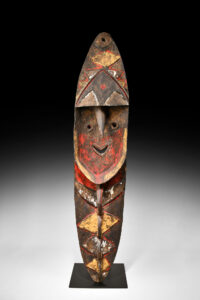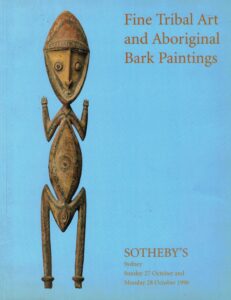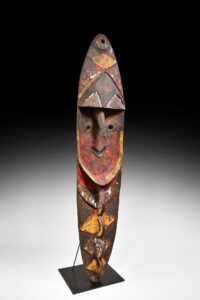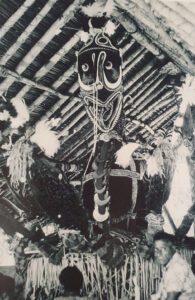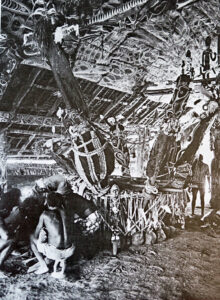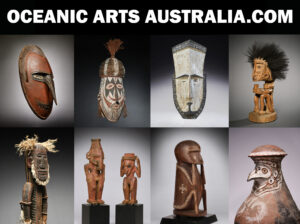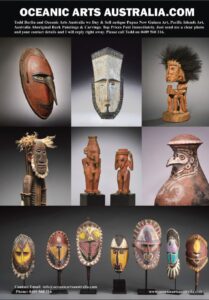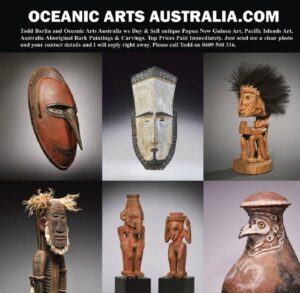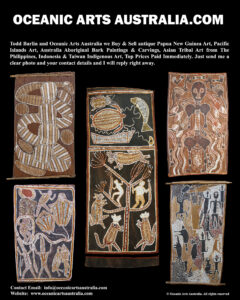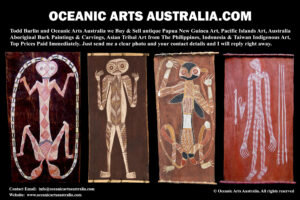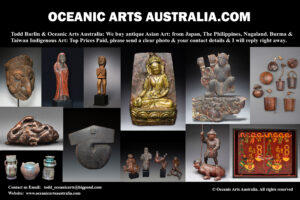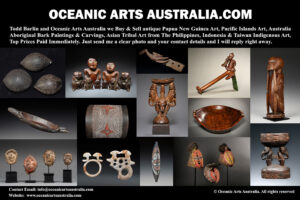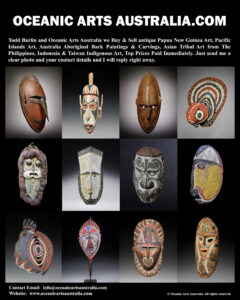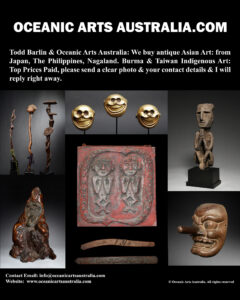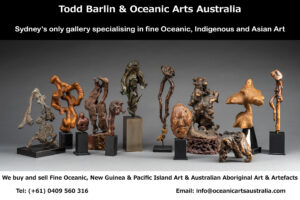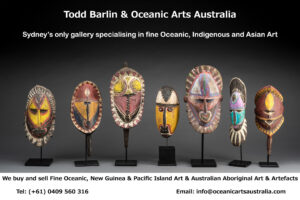A Superb Old New Guinea Minja Ceremonial Figure Kwoma People Waskuk Area Upper Sepik River Papua New Guinea
| Collection No. | T-5659 |
|---|---|
| Size | Height 169cm |
A Superb Old New Guinea Minja Ceremonial Figure, Kwoma People Waskuk Area, Upper Sepik River, Papua New Guinea
Minja is one of three distinct Yam Harvest ceremonies held annually in the villages of the Kwoma, Nukuma and Mayo speakers of the Upper Sepik River, in a region generally referred to as the Waskuk Hills, the two other Yam Harvest Ceremonies that are associated with a distinctive form of sculpture, the Yina & Nogkwi.
The Kwoma people and their closely related neighbours the Nukuma and Warasai & Yasyin share a unique tradition revolving around the cultivation of yams. An annual series of rituals associated with the yam harvest ensures the tuber’s continuing abundance and renders it suitable for human consumption. Clans sponsor the events, which are staged in a sequence of three rituals involving different types of ceremonial sculptures.
Minja is the second of the Yam Harvest Ceremonies. The essential iconographic feature is a highly stylized representation of a spirit figure. The shaft is associated with the yam digging stick, a tool used to dig holes for the yam planting. There is an obvious phallic and fertility symbol of the shaft (male) being thrust into the earth (female). Though strong symbols of maleness permeate the sculptural form, the Minja can be designated either male or female. Minja represents spirits known as sikilawos, which have great power and are responsible for the continuing fertility of the yam gardens.
Ritual leaders organize the Minja Ceremony at yam harvest time. The next two ceremonies feature their sculpted images of Yina and Nokwi and must also be performed before the full harvest is complete. Older Ceremonial Figures are hidden in garden huts, away from the village. They have acquired power over time and through use, new carvings are required from time to time; power is not inherent, but develops in the process of carving and painting.
For the annual ceremony, both old and new Minja sculptures are freshly painted, as their power lies in the bright polychrome ochre paint applied to their surfaces, for the Kwoma people the paint is a magical substance that endows the figures with supernatural power and beauty.
The ceremony takes place inside the men’s Ceremonial house (korob) A platform is built, and while one major Minja figure is displayed as a focus, many lesser Minja, other associated figures and pottery heads may be used. The Minja are tied to poles on the ceremonial platform and further decorated with shell wealth items, a ‘beard’ made of feather down, pig’s tusks and sometimes a headdress.
The Kwoma has a traditionally oriented ritual and aesthetic life. They believe in a complex pantheon of spirits. These fall into two categories: “bush” or “water” spirits occupying streams, boulders, or other natural features, collectively termed (in pidgin) masalai; and clan spirits depicted by ceremonial carvings.
The three major Kwoma Ceremonies focus on the harvesting of yams; in each, men display different styles of painted and decorated wooden sculptures depicting powerful clan spirits (the agents thought responsible for the continuing fertility of yam gardens) and dance around these sculptures singing complex song cycles that celebrate incidents of note in the histories of individual clans.
Like other Sepik peoples they are famous for their art, principally wood carvings and paintings on bark. The bulk of plastic art decorates ceremonial buildings. The ceilings of these structures are lined with hundreds of paintings of totemic species, and the posts and beams are lavishly carved with sculptures depicting mythological personages and spirits. Kwoma men’s houses are among the greatest of all artworks in the Pacific region.
This beautiful old sculpture is one of my favorite Oceanic Artworks that I have owned, it has a soft gentle feel where is often Middle Sepik artworks can seem aggressive, Waskuk/ Kwoma Art in my opinion is one of the great art styles of Papua New Guinea
Provenances: Phillip Goldman Galley UK (1922-2012)
The Allen Christensen Collection Allen Christensen 1908-1981
On Loan to the Art Gallery of West Australia 1978-1989
Sotheby’s Auctions Oct 27-28th 1996 Sydney Lot No 13 ( Lot 80 is also available)
The Todd Barlin Collection of New Guinea & Oceanic Art
In 1972, The Christensen Fund began to focus its support on the visual arts and bought its first art collection, a group of Pomo Indian baskets now at Harvard University’s Peabody Museum. When the late Allen Christensen took his mining and construction company to the far, exotic regions of the planet, he discovered a passion for artefacts to match his enthusiasm for business. The American civil and mining engineer’s giant family company, Utah Construction, was better known in some places for Christensen’s philanthropy, which ranged from marine research in New Guinea to medical research and a passion for artworks that he loaned to museums in the US and Australia. Christensen was a voracious collector of tribal and contemporary art. He collected tens of thousands of Indigenous artefacts and artworks in his travels over 30 years. He and his wife Carmen put them into the internationally respected Christensen Fund, which included Aboriginal works in an Australian collection.
References: Bowden, Ross: Yena: Art and Ceremony in a Sepik Society Pitt Rivers Museum Oxford 1983
Newton, Douglas Crocodile & Cassowary Museum of Primitive Art, NY.
Wardwell, Allen Island Ancestors Oceanic Art form the Masco Collection University of Washington Press 1994
See my new EXHIBITIONS GALLERY showing the Museums and Art Galleries Exhibitions that I provided artworks for over the past 40 years. There is the link to the article about my artworks published in the prestigious Louvre Magazine in 1996
I have artwork for Museums and art Galleries but also for collectors at every stage of their collecting. I want to encourage people to explore the fine art of New Guinea & West Papua and the Pacific Islands and to be able to see and touch the artworks in a relaxed and friendly manner in my Sydney Gallery. I would like to invite you to visit my gallery and see the artworks in person and also look at my website www.oceanicartsaustralia.com where there are many Galleries & Sub Galleries to explore.
My Gallery of nearly 40 years is the last physical gallery in Sydney that specializes in New Guinea and Oceanic Art. Sydney is very close to New Guinea & the Pacific Islands where all of these amazing artworks came from, Australia’s closest neighbours.
To see many more rare items and the finest masterpieces, please make an appointment with us to visit the gallery.
For all inquiries, please contact us

